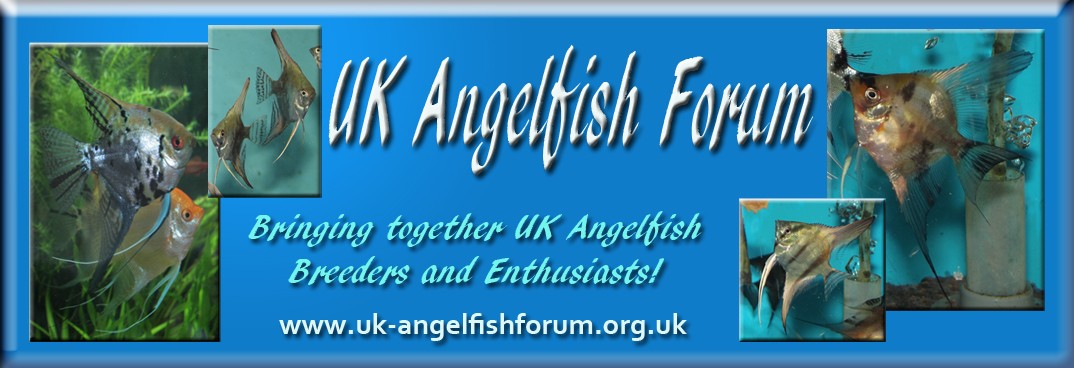Latest topics


line breeding
2 posters
Page 1 of 1
 line breeding
line breeding
Being new to angelfish , do people line breed angelfish to increase a change in colour . Also do you do test breeding to check and see if a angelfish has hets.
javen- Posts : 12
Join date : 2015-11-25
Location : norfolk
 Re: line breeding
Re: line breeding
Line breeding can be a very effective way of "fixing" desirable traits, and contrary to popular wisdom, if done properly, it can be a very effective method of eliminating genetic weaknesses & deformities from a population. The key point, if done properly.
In the USA Steve Rybicki & Dave Hlasnick of Angels plus http://www.angelsplus.com/ have been line breeding koi for 30 odd years, with quite spectacular results.
you might find this informative http://www.newbreedkoi.com/welcome.html
The main drawback with line breeding is that as well as "fixing" desirable genes, unless carried out very carefully, inbreeding can also "fix" undesirable traits resulting in fish that produce a high percentage of weak & deformed offspring. The way to overcome this is firstly, breed lots of fish, and be incredibly selective about which of them you use as breeders; and secondly maintain several distinct lines, which you can cross into your main line where necessary. All this requires a large number of tanks and a more ruthless approach to culling substandard fish than most breeders are willing or able to devote to the project.
Personally I try to keep track of all my fish and work to minimise inbreeding, but at the same time, knowing the parentage of most of my fish going back several generations, I'm able to select fish that have the genes I require to produce the varieties I want to breed.
That said, the occasional sibling x sibling cross is usually not a problem. On the other hand, unwitting inbreeding can be.
As an example
Breeder A finds an unusual looking fish in one of his batches, lets call it a "red stunner". So he breeds it back to it's mother & produces some offspring, and because he's dealing with a recessive gene half of them are red stunners. These offspring will have a coefficient of inbreeding of 25%. The breeder realises this could be a highly marketable variety, so he selects 6 pairs from these youngsters and sets them up in breeding tanks. Over the next few months he builds up stocks until his fish room is bursting at the seams & he's got a few thousand fish (with a coefficient of inbreeding of 37.5%) ready to unleash on the trade. Having sold many to local shops, and hobbyists, he takes the rest to a wholesaler. A month later the wholesaler is back for more and the breeder is struggling to meet demand.
The breeder knows that ideally he should do an outcross, but that would result in a generation without any red stunners, so instead he sets up some more pairs from the 37.5% in bred to up his production, not all will be sibling x sibling pairs, but all their parents were, so inbreeding increases further.
If the story stopped there, demand calmed down and the breeder got into a routine of doing some out crosses whilst still meeting demand, the story would have a happy ending, unfortunately, that's not where it stops :-
Hobbyist breeders notice this new variety, and decide they too want a piece of the action, so they buy themselves a couple of pairs and go into production. They find a ready market as Breeder A can't supply the wholesalers with enough to meet demand.
Well to cut a long story short, after a couple of generations of their own, each breeder of "Red Stunners" starts to notice that they're not as tough, hardy or as large as the wild type. Some plough on regardless, but the more knowledgeable realise that inbreeding is probably an issue, so they seek new blood. They may travel the country or swap stock with breeders who got their original breeding stock from a "different source", unfortunately, because few if any have been doing any out-crosses, the stock they bring in to strengthen their blood lines is probably closely related to their existing stock.
Eventually they become disillusioned and "red stunners" get a reputation for being small, weak and sickly.
I've found the following an interesting, if difficult, read on the subject of inbreeding http://www.fao.org/docrep/006/x3840e/X3840E00.HTM
In the USA Steve Rybicki & Dave Hlasnick of Angels plus http://www.angelsplus.com/ have been line breeding koi for 30 odd years, with quite spectacular results.
you might find this informative http://www.newbreedkoi.com/welcome.html
The main drawback with line breeding is that as well as "fixing" desirable genes, unless carried out very carefully, inbreeding can also "fix" undesirable traits resulting in fish that produce a high percentage of weak & deformed offspring. The way to overcome this is firstly, breed lots of fish, and be incredibly selective about which of them you use as breeders; and secondly maintain several distinct lines, which you can cross into your main line where necessary. All this requires a large number of tanks and a more ruthless approach to culling substandard fish than most breeders are willing or able to devote to the project.
Personally I try to keep track of all my fish and work to minimise inbreeding, but at the same time, knowing the parentage of most of my fish going back several generations, I'm able to select fish that have the genes I require to produce the varieties I want to breed.
That said, the occasional sibling x sibling cross is usually not a problem. On the other hand, unwitting inbreeding can be.
As an example
Breeder A finds an unusual looking fish in one of his batches, lets call it a "red stunner". So he breeds it back to it's mother & produces some offspring, and because he's dealing with a recessive gene half of them are red stunners. These offspring will have a coefficient of inbreeding of 25%. The breeder realises this could be a highly marketable variety, so he selects 6 pairs from these youngsters and sets them up in breeding tanks. Over the next few months he builds up stocks until his fish room is bursting at the seams & he's got a few thousand fish (with a coefficient of inbreeding of 37.5%) ready to unleash on the trade. Having sold many to local shops, and hobbyists, he takes the rest to a wholesaler. A month later the wholesaler is back for more and the breeder is struggling to meet demand.
The breeder knows that ideally he should do an outcross, but that would result in a generation without any red stunners, so instead he sets up some more pairs from the 37.5% in bred to up his production, not all will be sibling x sibling pairs, but all their parents were, so inbreeding increases further.
If the story stopped there, demand calmed down and the breeder got into a routine of doing some out crosses whilst still meeting demand, the story would have a happy ending, unfortunately, that's not where it stops :-
Hobbyist breeders notice this new variety, and decide they too want a piece of the action, so they buy themselves a couple of pairs and go into production. They find a ready market as Breeder A can't supply the wholesalers with enough to meet demand.
Well to cut a long story short, after a couple of generations of their own, each breeder of "Red Stunners" starts to notice that they're not as tough, hardy or as large as the wild type. Some plough on regardless, but the more knowledgeable realise that inbreeding is probably an issue, so they seek new blood. They may travel the country or swap stock with breeders who got their original breeding stock from a "different source", unfortunately, because few if any have been doing any out-crosses, the stock they bring in to strengthen their blood lines is probably closely related to their existing stock.
Eventually they become disillusioned and "red stunners" get a reputation for being small, weak and sickly.
I've found the following an interesting, if difficult, read on the subject of inbreeding http://www.fao.org/docrep/006/x3840e/X3840E00.HTM

Pterophyllum- Posts : 1554
Join date : 2012-02-08
Location : Gloucestershire
 Similar topics
Similar topics» New Spawn - Black x Albino Gold Peralscale
» Anglefish breeding
» Breeding setups?
» Angel Pairs Partial to Caviar
» what equipment would i need for breeding.
» Anglefish breeding
» Breeding setups?
» Angel Pairs Partial to Caviar
» what equipment would i need for breeding.
Page 1 of 1
Permissions in this forum:
You cannot reply to topics in this forum

» Is there anybody out there?
» Which option would you choose?
» Need help theirs something wrong angelfish are acting really strange
» Hi all. =)
» Disaster has struck!!!
» Scottish Members.
» Keeping angelfish fry in the parents tank
» Just Testing